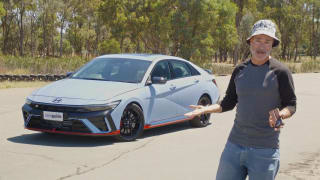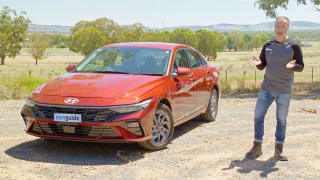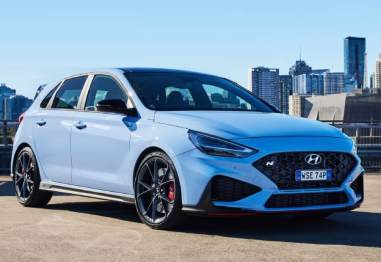
What's on this page
Hyundai I30 2024
Carsguide Managing Editor Tim Nicholson had this to say at the time: Note: CarsGuide attended this event as a guest of the manufacturer, with travel, accommodation and meals provided.
You can read the full review here.The 2024 Hyundai i30 carries a braked towing capacity of up to 1300 Kg, but check to ensure this applies to the configuration you're considering.
The Hyundai i30 is also known as the Hyundai Elantra GT in markets outside Australia.
Hyundai I30 2024 News

The best new cars in 2024! From family hatchbacks to superbly-executed 4WDs and groundbreaking EVs, these are CarsGuide's Top 10 rated cars of the year

Is your new car really safer: How would an old Toyota Corolla or Hyundai i30 cope in a crash with a newer model? The answer might surprise you

Enough already! Updates on the redesigned Toyota Corolla, Mazda 3 and Hyundai i30 - and why Kia may save the day for buyers of affordable quality small cars

Popular car hit with three-star safety rating: Toyota Corolla, Mazda 3 and Kia Cerato rivalling 2025 Hyundai i30 sedan just falls short of four stars
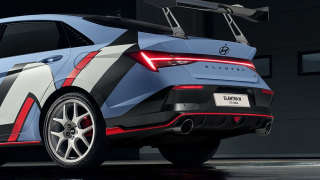
Special new performance car revealed: 2025 Hyundai i30 N sedan TCR Edition released with Australian launch on the cards next year

Hyundai i30 sedan range gets price cut

Still the cheapest hot hatch? 2025 Hyundai i30 N pricing and features revealed but does it undercut the VW Golf GTI, Subaru WRX and Honda Civic Type R?

Hyundai's Volkswagen Golf GTI and Honda Civic Type R rivalling i30 N hatchback gets vital upgrades with Australian release locked in for August

Popular cheap car's price jumps $12,000: 2025 Hyundai i30 new hybrid range might be worth it against Toyota Corolla, Mazda 3, Honda Civic, Peugeot 308 and more-expensive German alternatives
Hyundai I30 2024 Price and Specs
Pricing guides

| Hyundai I30 Model | Body Type | Specs | Price from | Price to | |
|---|---|---|---|---|---|
| Active | Hatchback | 2.0L — 6 SP AUTO | $23,650 | $29,260 | |
| (base) | Hatchback | 2.0L — 6 SP AUTO | $22,440 | $27,720 | |
| (base) | Hatchback | 2.0L — 6 SP MAN | $20,130 | $25,520 | |
| Elite | Hatchback | 2.0L — 6 SP AUTO | $26,510 | $32,780 | |
| (BEV) | Sedan | 1.6L — 6 SP DUAL-CLUTCH AUTO | $29,480 | $35,530 | |
| (base) | Sedan | 2.0L — CVT AUTO | $25,190 | $31,130 | |
| Elite | Sedan | 2.0L — CVT AUTO | $29,810 | $35,860 | |
| Elite HEV 1.6P DCT | Sedan | 1.6L — 6 SP DUAL-CLUTCH AUTO | $33,550 | $39,930 | |
Hyundai I30 2024 Colours
The i30 Sedan N is available in signature-N Performance Blue, along with solid Atlas White, Cyber Grey, Ultimate Red and Intense Blue Metallic, and Ecotronic Grey and Abyss Black Mica.
Mica and metallic paint add $595 to the price.
- Ecotronic Grey
- Intense Blue
- Ultimate Red
- Atlas White
- Abyss Black
Hyundai I30 2024 Accessories
All i30 Sedan Hybrids include LED headlights, Autonomous Emergency Braking (AEB), adaptive cruise control with full-stop go, USB-C outlets front and rear, electronic instrumentation, a wireless phone charger, access to Hyundai’s Blue-Link server-based voice-control subscription service, a centre touchscreen, plugged Apple CarPlay/Android Auto, front and rear sensors, a rear camera, Bluetooth connectivity, a leather steering wheel, rear air vents and alloy wheels.
In the base model Hybrid, the buyer also scores a multi-link independent rear suspension arrangement, dual-zone climate-control and rain-sensing wipers. Bonus as in the entry-level petrol versions, these are not available.
Stepping up to the Hybrid Elite, you’ll find blind-spot monitoring, safe-exit warning, rear cross-traffic alert, a larger touchscreen at 10.25-inches instead of 8.0 inches, keyless entry/start, leather, DAB+ digital radio and 17-inch alloys.
Finally, the Hybrid Premium lives up to its name with a sunroof, blind-spot view monitor, surround-view camera, rear collision avoidance, a Bose audio upgrade, dual projector headlights, LED tail-lights, heated/vented front seats, a powered driver’s seat with memory, heated steering wheel, solar control glass and more.
The i30 Sedan N, meanwhile, has 19-inch alloys, sports bucket front seats and more.
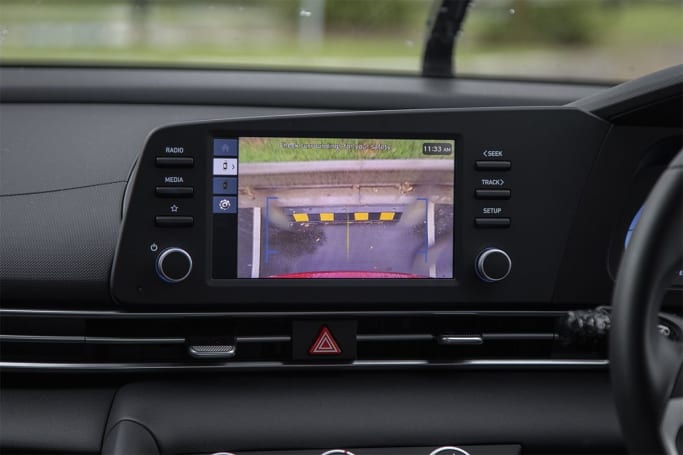
Hyundai I30 2024 Q&As
Check out real-world situations relating to the Hyundai i30 here, particularly what our experts have to say about them.
-
When should the timing belt be replaced on my 2011 Hyundai i30?
You’re in luck here, Tony, because both the petrol and diesel engines fitted to this generation of the i30 used timing chains rather than rubber toothed timing belts. As such, the chain should be good for the life of the engine, rather than requiring scheduled replacement like a timing belt.
For the record, most manufacturers say a rubber timing-belt should be changed (roughly) at 100,000km or 10-year intervals. That said, some carmakers recommend much shorter intervals, so it’s worth knowing this stuff. A failed timing belt will often destroy the rest of the engine, but so can a timing chain if it fails. It’s just that a chain is much less likely to fail in service.
Show more -
Power steering in Hyundai i30 won't turn off
Various systems randomly turning themselves on or staying powered up when the car is otherwise turned off often point to a fault with the body computer which controls literally hundreds of functions. Obviously, the power steering should shut down with the rest of the car so, as the master control unit, the body computer is where many mechanics would start looking.
Whether the same fault is also causing the ESP light to come on is another matter, but it’s possible both problems are connected. Again, the body computer is a likely culprit. Have the car scanned to see what and how many individual fault codes are thrown up. That’s the best way to proceed in this case.
Show more -
Could an electrical fault with my GPS and bluetooth affect the reversing camera?
Glad to hear you've had such a great run with your car. I understand what a great safety device a reverse camera is, and if it was standard fitment in your car when it was new, it could very well be a roadworthy item if it's not working. However, I wouldn't be too worried as the GPS and bluetooth functions should not be related to the reverse camera or the cruise-control.
If the reverse camera screen ever went on the blink, you could fairly cheaply add a replacement aftermarket unit which would also restore your Bluetooth and possibly even your GPS functions.
Show more -
Could an electrical fault with my GPS and bluetooth affect the reversing camera?
Glad to hear you've had such a great run with your car. I understand what a great safety device a reverse camera is, and if it was standard fitment in your car when it was new, it could very well be a roadworthy item if it's not working. However, I wouldn't be too worried as the GPS and bluetooth functions should not be related to the reverse camera or the cruise-control.
If the reverse camera screen ever went on the blink, you could fairly cheaply add a replacement aftermarket unit which would also restore your Bluetooth and possibly even your GPS functions.
Show more
Hyundai I30 2024 Dimensions
Dimensions for the 2024 Hyundai i30 are dependent on which body type is chosen. The maximum width and height is 1825mm x 1455mm and can vary on the basis of model.

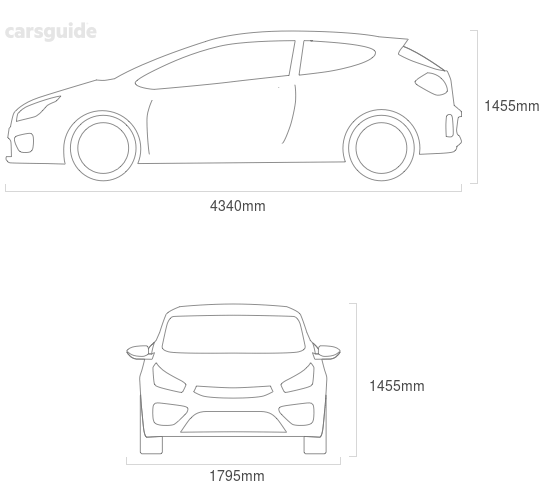
| Hyundai i30 Model | Body Type | Height x Width x Length | Ground Clearance | |
|---|---|---|---|---|
| base | Hatchback | 1455x1795x4340 mm | 140 mm | |
| Active | Hatchback | 1455x1795x4340 mm | 140 mm | |
| N Line | Hatchback | 1453x1795x4345 mm | 135 mm | |
| Elite | Hatchback | 1455x1795x4340 mm | 140 mm | |
| base | Sedan | 1420x1825x4710 mm | 140 mm | |
| (BEV) | Sedan | 1420x1825x4710 mm | 140 mm | |
| HEV 1.6P DCT | Sedan | 1420x1825x4710 mm | 140 mm | |
| Elite | Sedan | 1420x1825x4710 mm | 140 mm | |
Hyundai I30 2024 Fuel consumption
Fuel consumption for the 2024 Hyundai i30 is dependent on the type of engine, transmission, or model chosen. The Hyundai i30 currently offers fuel consumption from 3.9 to 8.5L/100km. The Hyundai i30 is available with the following fuel type: —.
| Hyundai i30 Model | Body Type | Specs | Fuel Consumption | |
|---|---|---|---|---|
| Active | Hatchback | 2.0L,—,6 SP AUTO | 7.4L/100km | |
| base | Hatchback | 2.0L,—,6 SP MAN | 7.3L/100km | |
| (BEV) | Sedan | 1.6L,—,6 SP DUAL-CLUTCH AUTO | 3.9L/100km | |
| base | Sedan | 2.0L,—,CVT AUTO | 6.1L/100km | |
Hyundai I30 2024 Wheel size
Wheel size for the 2024 Hyundai i30 will vary depending on model chosen, although keep in mind that many manufacturers offer alternate wheel sizes as options on many models.The wheel size available will alter the range of tyres available to be fitted.
| Hyundai i30 Model | Body Type | Front Tyre Size | Front Rim | Rear Tyre Size | Rear Rim | |
|---|---|---|---|---|---|---|
| base | Hatchback | 205x55 R16 9 | — | 205x55 R16 9 | — | |
| Active | Hatchback | 225x45 R17 9 | — | 225x45 R17 9 | — | |
| N Line | Hatchback | 225x40 R18 9 | — | 225x40 R18 9 | — | |
| Elite | Hatchback | 225x45 R17 9 | — | 225x45 R17 9 | — | |
| base | Sedan | 205x55 R16 9 | — | 205x55 R16 9 | — | |
| (BEV) | Sedan | 205x55 R16 9 | — | 205x55 R16 9 | — | |
| HEV 1.6P DCT | Sedan | 205x55 R16 9 | — | 205x55 R16 9 | — | |
| Elite | Sedan | 225x45 R17 9 | — | 225x45 R17 9 | — | |
Hyundai I30 2024 Interior
The i30 Sedan Hybrid’s interior is more spacious than your average C-segment four-door sedan, owing to a long wheelbase and wide tracks.
Hyundai has styled the dashboard to face the driver, allowing for extra clarity, unimpeded access and an inclusive feel. Keep in mind, though, that the base-model version’s dashboard treatment seems basic.
The driving position is exemplary, there’s lots of storage, and the multimedia functionality is fast and simple; the same goes for the ventilation system operation, while vision out is OK except when reversing, due to the high boot line and narrow glass area.
It’s a good thing a camera is standard.
Base cars have an 8.0-inch centre screen and an austere LCD instrument cluster. Stepping up to the Elite and up brings a larger touchscreen in the centre as well as a bigger (at 10.25 inches) as well as more-comprehensive digital instrumentation dials that are configurable.
Beware that the left-front buttress handle running across the lower left-hand side of the centre console can foul the front passenger’s right knee if they’re sit in a splayed position, or even feel tight against the thighs.
Still, the rest of the cabin offers first-class fit and finish.
Being a largish small sedan, the back-seat area, too, scores for available room and comfort, though the swoopy roofline makes getting in and out tricky if you do not want to hit your head.
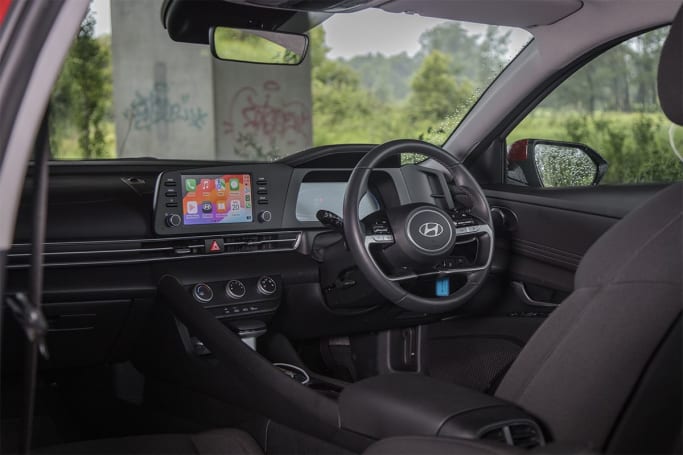
Hyundai I30 2024 Engine
The i30 Sedan is offered with four petrol engine choices, starting with a 120kW/203Nm 2.0-litre four-cylinder unit driving the front wheels via a CVT transmission.
The popular N-Line switches to a 150kW/265Nm 1.6L turbo with a seven-speed dual-clutch transmission driving the front wheels.
Meanwhile, the Hybrid’s powertrain consists of a 1.6-litre GDi gasoline direct-injection four-cylinder petrol engine, making 77kW of power at 5700rpm and 147Nm of torque at 4000rpm on its own.
But paired with a 32kW/170Nm electric motor, and fed by a 1.32kWh Lithium Ion battery, total outputs leap to 104kW and 265Nm.
The Hybrid drives the front wheels via a six-speed dual-clutch transmission (DCT).
The i30 Sedan N is fitted with a 2.0-litre direct-injection four-cylinder turbo petrol engine, making 206kW of power at 6000rpm and 392Nm of torque from just 2100 to 4700rpm.
Drive is delivered to the front wheels via an eight-speed dual-clutch transmission (DCT), and controlled by a limited slip differential.

Hyundai I30 2024 Boot Space
The boot is a great size with its 474L of capacity! Like most sedans, it has a narrow opening but you shouldn't have any issues accessing items at the back. You get a full-size spare wheel.
The i30 Sedan N has 464L of cargo capacity, with cabin access via the 60:40 split/fold backrest. That’s 10L shy of the regular non-N sedans.
Under the flat and wide floor is a space-saver spare wheel.
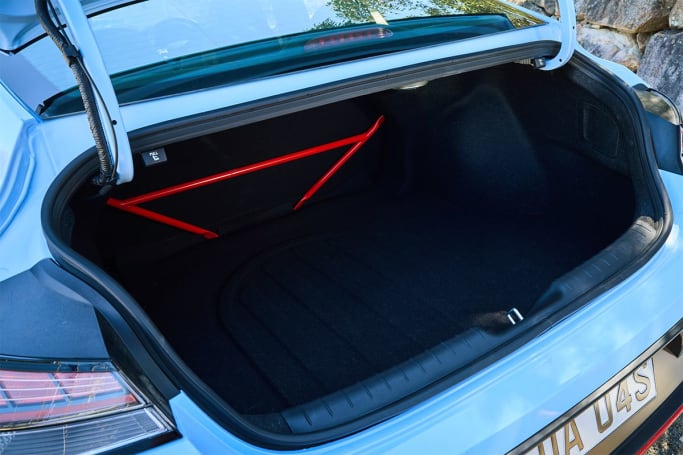
Hyundai I30 2024 Towing capacity
The Hyundai i30’s towing capacity ranges from 0kg to 1300kg. Some models also offer heavy-duty or towing option packs which can increase towing capacity, as well as options which can hamper towing capacity. Towing capacities can vary wildly on a large number of factors. These include engine, transmission, model, and options chosen. Always check with the manufacturer or in your vehicles handbook before attempting to tow anything.
| Hyundai i30 Model | Body Type | Specs | Braked Capacity | |
|---|---|---|---|---|
| base | Hatchback | 2.0L,—,6 SP MAN | 1300kg | |
| base | Hatchback | 2.0L,—,6 SP AUTO | 1300kg | |
| Active | Hatchback | 2.0L,—,6 SP AUTO | 1300kg | |
| N Line | Hatchback | 1.6L,—,6 SP MAN | 1300kg | |
| base | Sedan | 2.0L,—,CVT AUTO | 1100kg | |
| HEV 1.6P DCT | Sedan | 1.6L,—,6 SP DUAL-CLUTCH AUTO | 0kg | |
| (BEV) | Sedan | 1.6L,—,6 SP DUAL-CLUTCH AUTO | 0kg | |
| Elite | Sedan | 2.0L,—,CVT AUTO | 1100kg | |
Hyundai I30 2024 Speed
The Hyundai i30 Sedan N can accelerate from standstill to 100km/h (0-100km/h) in around 5.3 seconds, on the way to a top speed of 250km/h.
Hyundai I30 2024 Seats
The i30 Sedan Hybrid is a full five-seater sedan, with comfortable bucket-type seats offering angle and height adjustment up front and a rear bench accommodating three people up to and including adult size.
The rear bench has a 60:40-split backrest at a fixed angle, with the larger portion also containing a centre armrest containing two large cupholders.
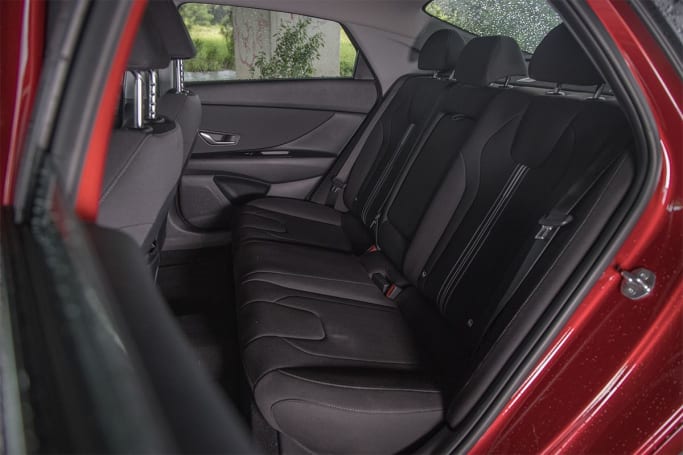
Hyundai I30 2024 Range
The Euro-5-standard i30 Sedan hybrid averages 3.9 litres per 100km on the combined cycle, which matches to a carbon dioxide emissions rating of 92 grams/km.
On the highway cycle that bumps up to 4.0L/100km, or just 2.8L/100km on the urban run.
Even with a modest 42L fuel tank, that means about 1500km between refills is technically possible, drinking standard 91 RON unleaded petrol. E10 ethanol-blend is also allowed.
On the launch the trip computer read an average of 5.1L/100km.
The regular i30 Sedan with the base 2.0L averages 6.1L/100km, versus 6.6L for the N-Line's 1.6-turbo alternative.
Meanwhile, the Euro-5-standard i30 Sedan N averages 8.5 litres per 100km on the combined cycle in manual mode, or 8.3L in DCT guise, which matches to a carbon dioxide emissions rating of 198 and 194 grams/km respectively.
On the highway cycle that bumps up to 11.8L/100km, or down to 6.3L/100km on the urban run.
The 47L fuel tank should be able to allow a range of about 565km, running on 95 RON premium unleaded petrol.
On the launch the trip computer read an average of 10.0L/100km.



